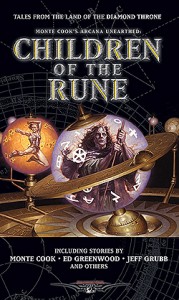 Based on the role-playing game Arcana Unearthed, created by Monte Cook, this is a collection of stories told in the land of the Diamond Throne. The quick rundown: numerous fantastical races inhabit various parts of the land of the Diamond Throne, including the reptilian mojh, giants, humans, sprytes, and the leonine litorians. Every so often, someone will be granted amazing powers, as represented by a mysterious runic tattoo which identifies them to one another and the world. What these so-called runechildren do with their powers varies tremendously from being to being. Some are good, some bad. Some warriors, some mystics. All are unique in their own way.
Based on the role-playing game Arcana Unearthed, created by Monte Cook, this is a collection of stories told in the land of the Diamond Throne. The quick rundown: numerous fantastical races inhabit various parts of the land of the Diamond Throne, including the reptilian mojh, giants, humans, sprytes, and the leonine litorians. Every so often, someone will be granted amazing powers, as represented by a mysterious runic tattoo which identifies them to one another and the world. What these so-called runechildren do with their powers varies tremendously from being to being. Some are good, some bad. Some warriors, some mystics. All are unique in their own way.
The thirteen stories contained in this volume explore the many possible paths the runechildren can take, from thief to healer, con man to warrior, martyr to villain. Authors represented include role-playing game fiction mainstays Lucien Soulban, Ed Greenwood, Jeff Grubb, Richard Lee Byers, and Monte Cook himself.
It’s always hard presenting a collection of work based on a game setting: you have to walk a delicate balance between staying original, and staying true to the game, telling stories without making it feel like a game session transcribed. Too often, characters that succeed on the gaming table fail when forced to carry a real story. Furthermore, the story runs the risk of trying to convey too much of the setting information. Too much, and it’s overwhelming. Too little, and it’s generic fantasy. Luckily, Children of the Rune manages to walk the middle ground more often than not, telling some fascinating fantasy stories without succumbing to the many pitfalls available to such an endeavor. Were I more of a fantasy gamer, I’d be a lot more tempted to check out Monte Cook’s Arcana Unearthed, based on the potential tapped in Children of the Rune. As a stand-alone collection, furthermore, it holds up fairly well, even if the setting introduction feels like a lot to take in all at once. Fans of Forgotten Realms and Dragonlance might want to check this out.
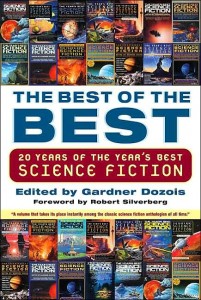 Just a few months ago, I lavished praise upon the most recent volume of Dozois’ Year’s Best Science Fiction. Now we have Best of the Best, an impressive paperback tome which draws upon the first twenty volumes in the series to offer up a fascinating retrospective. As Dozois acknowledges, it’s a purely subjective effort; his choices were influenced by mood, timing, space constraints, and the need to balance out better-known works with lesser-known ones. If compiled a month later or a week earlier, the lineup could have been quite different. And, of course, it’s one man’s opinion. That said, what we have here is still pretty darned incredible: three dozen stories, taken from twenty years worth of the Year’s Best collections, representing the many facets and the vast potential of the science fiction genre.
Just a few months ago, I lavished praise upon the most recent volume of Dozois’ Year’s Best Science Fiction. Now we have Best of the Best, an impressive paperback tome which draws upon the first twenty volumes in the series to offer up a fascinating retrospective. As Dozois acknowledges, it’s a purely subjective effort; his choices were influenced by mood, timing, space constraints, and the need to balance out better-known works with lesser-known ones. If compiled a month later or a week earlier, the lineup could have been quite different. And, of course, it’s one man’s opinion. That said, what we have here is still pretty darned incredible: three dozen stories, taken from twenty years worth of the Year’s Best collections, representing the many facets and the vast potential of the science fiction genre.
This volume is chock-full of excellent stories and fan-favorite authors, many of them award winners in one capacity or another. In here, you’ll find Greg Bear, Nancy Kress, Bruce Sterling, Robert Silverberg, Mike Resnick, Joe Haldeman, Connie Willis, Michael Swanwick, Ursula K. LeGuin, Ted Chiang, and many more. To detail the stories themselves, I’d need a lot more space. Suffice it to say that if you’re a fan of science fiction, and you like short stories, it would be a gross oversight not to check this book out for yourself. Normally, I’d say that a title like Best of the Best is like waving a red flag at a bull, but the truth is, Dozois makes a persuasive case with his choices. I’d happily hand this collection to someone who wanted to see what science fiction is capable of, or who wanted a general introduction to the field.
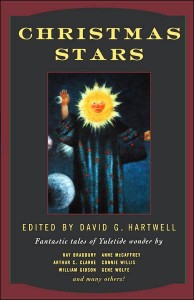 Originally published in 1992, and released last year just in time for Christmas, it’s obvious what the unifying theme of this anthology is: Christmas as re-envisioned in science fiction and fantasy. There’s plenty of interesting stories to choose from here, looking at the holiday and its most notable icons in all sorts of different lights. Of note are stories like Connie Willis’ charming “Miracle,” James Powell’s whimsically twisted “The Plot Against Santa Claus,” Edward Wellen’s dystopian “Sanity Clause,” and Ben Bova’s introspective “Silent Night.” Other authors to be found here include Spider Robinson, Gene Wolfe, Anne McCaffrey, Ray Bradbury, John Ford, Arthur C. Clarke, and William Gibson.
Originally published in 1992, and released last year just in time for Christmas, it’s obvious what the unifying theme of this anthology is: Christmas as re-envisioned in science fiction and fantasy. There’s plenty of interesting stories to choose from here, looking at the holiday and its most notable icons in all sorts of different lights. Of note are stories like Connie Willis’ charming “Miracle,” James Powell’s whimsically twisted “The Plot Against Santa Claus,” Edward Wellen’s dystopian “Sanity Clause,” and Ben Bova’s introspective “Silent Night.” Other authors to be found here include Spider Robinson, Gene Wolfe, Anne McCaffrey, Ray Bradbury, John Ford, Arthur C. Clarke, and William Gibson.
While every year brings us at least one, if not two or three, Christmas-themed anthologies, Christmas Stars still stands above the rest, like the angel on the tree, by virtue of an all-star lineup and some classic reprints that deserve to stay available for new generations to read. It was good to see this collection on the shelves again after a length absence, and even though by the time this sees print, it’ll be well into spring, it might be worth looking for Christmas Stars. Christmas in July, anyone?
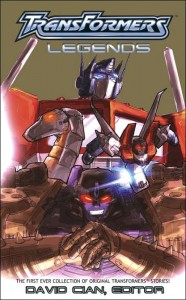 While the Transformers franchise has been in existence steadily since it first hit America back in the early ‘80s, it still seems to primarily carry that ‘80s atmosphere, no matter how it’s updated or changed every few years. Whether the ever-popular giant robots transform into cars, airplanes, gorillas, spaceships, or two-headed flying tigers, they still manage to hang onto the essential elements. Ask anyone who’s even remotely familiar with the Transformers mythos, and they’ll be able to tell you about Optimus Prime and Megatron, even if they’re fuzzy on the other thousand or so characters which have sprung up across four or five different and distinct generations. However, though there have been plenty of cartoon series, several different comic books, and uncounted toys to flesh out the brand, the fiction aspect of Transformers has mostly been left alone, until now.
While the Transformers franchise has been in existence steadily since it first hit America back in the early ‘80s, it still seems to primarily carry that ‘80s atmosphere, no matter how it’s updated or changed every few years. Whether the ever-popular giant robots transform into cars, airplanes, gorillas, spaceships, or two-headed flying tigers, they still manage to hang onto the essential elements. Ask anyone who’s even remotely familiar with the Transformers mythos, and they’ll be able to tell you about Optimus Prime and Megatron, even if they’re fuzzy on the other thousand or so characters which have sprung up across four or five different and distinct generations. However, though there have been plenty of cartoon series, several different comic books, and uncounted toys to flesh out the brand, the fiction aspect of Transformers has mostly been left alone, until now.
Transformers Legends is the first (to my knowledge) anthology to collect stories about the various aspects of the Transformers universe, from Generation 1 to Armada, from Beast Wars to Robots in Disguise. No stone is left unturned in the process, and the thirteen stories within certainly manage to offer something to please any fan of the franchise, no matter what era they most identify with. Fan favorite Simon Furman, long credited with telling some of the most dynamic comic stories of the original Transformers, is featured with his story, “A Meeting of Minds,” which looks at a pivotal moment in the Beast Wars/Machines era, when one Megatron met another, to devastating effect.
Another standout story is Alexander Potter’s “Redemption Center,” in which the quintessentially treacherous Decepticon known as Starscream is granted a second chance at trust, companionship, and a sense of belonging. In a true question of nature versus nurture, he has to decide between factions and loyalties while struggling with the dictates of his programming.
Other stories look at the Minicons (John J. Miller’s “Something Robotic This Way Comes”), the popular robot known as Bumblebee (Jennifer A. Ruth’s “Joyride”), the many incarnations of Optimus Prime (Sean Fodora’s Prime Spark”), and the strange history of the Armada universe (John Helfer’s “Fire in the Dark”). All in all, this is an excellent anthology for fans of the Transformers universe, touching upon enough facets of the concept to please just about any fan. However, this is definitely a collection for fans; newcomers might be lost amidst the unfamiliar names and references scattered throughout.
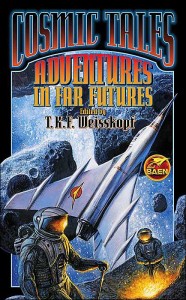 Offered as a followup to Cosmic Tales: Adventures in Sol System, this collection of stories pushes the limits, taking its various protagonists to distant stars and farflung settings. Like the title suggests, the stories are weighted towards adventure tales and space opera, with plenty of action to go around. There’s only six stories, plus an accompanying nonfiction essay, to fill out the volume, which means most of the stories are novella length or even longer.
Offered as a followup to Cosmic Tales: Adventures in Sol System, this collection of stories pushes the limits, taking its various protagonists to distant stars and farflung settings. Like the title suggests, the stories are weighted towards adventure tales and space opera, with plenty of action to go around. There’s only six stories, plus an accompanying nonfiction essay, to fill out the volume, which means most of the stories are novella length or even longer.
By far, my favorite of the six is Debra Doyle and James MacDonald’s return to their Mageworlds setting, in “On Suivi Point.” In it, we’re treated to a glimpse of Beka Rosselin-Metadi’s early adventures as a spacer, before she was recalled home by the events detailed in Price of the Stars. While on leave on Suivi Point, she and a companion are targeted as part of a shadowy conspiracy, but it soon turns out that Beka’s inadvertent enemies are the ones in trouble. It never pays to underestimate some people.
Also of interest is “Genie Out of the Bottle” by Dave Freer and Eric Flint, which looks at the setting introduced in Rats, Bats and Vats. Who ever thought combining the military and genetic engineering would be so unusual? A privileged young man joins the army to get out of a bad jam that’s not his fault, and ends up working with the dregs of an army created from genetically-altered elephant-shrews (commonly called “rats”). His unorthodox way of working with them turns out to have unexpected consequences. Fascinating, fun, and worth checking out, this story’s inspired me to go find the books it ties into.
Other stories in this collection are from James P. Hogan, Mark L. Van Name, Paul Chafe, and Gregory Benford. In general, I was pleased with Cosmic Tales, and I hope we’ll continue to see more releases in this series, as so far, it’s been quite entertaining.
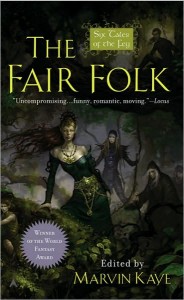 Contrary to popular belief as embodied by Yours Truly, the Science Fiction Book Club occasionally commissions collections of original short fiction, a fact which came as something of a surprise when I received this book in the mail. The six stories collected in The Fair Folk are loosely unified, revolving around the general theme of fairies and their interactions with the mortal world. All six are of novella length or longer, thus giving the authors room to spread out and tell the complex stories that call to them.
Contrary to popular belief as embodied by Yours Truly, the Science Fiction Book Club occasionally commissions collections of original short fiction, a fact which came as something of a surprise when I received this book in the mail. The six stories collected in The Fair Folk are loosely unified, revolving around the general theme of fairies and their interactions with the mortal world. All six are of novella length or longer, thus giving the authors room to spread out and tell the complex stories that call to them.
“UOUS,” by Tanith Lee, is a brilliant twist on the three wishes concept which is so often found in traditional fairy tales. Lois, a Cinderella-like girl whose home life is downright unbearable, makes an unknowing, foolish pact with a lord of the Fae, and is thus pressed into his service, compelled to grant -him- three wishes, as repayment for all those centuries the Fae served humans. The results are horrifying and disturbing, but fitting nonetheless. Lee manages to infuse the unsettling magic of the Fae with a certain cheap, tawdry feeling brought in from the mortal world, making this as close to a reverse fairy tale as ever I’ve seen. There are happy endings, but not as so we’d normally predict. The desperation and shame of the main character as she undergoes her trials is excellently conveyed, so that we really feel her being cast down even as she succeeds in improving her life. Lee’s managed to say something new, here, and it shows.
Megan Lindholm’s “Grace Notes” is the story of an everyday guy who ends up with a brownie in his home. She cooks, she cleans, she redecorates, she watches Martha Stewart, and she does it all invisibly and impeccably. Unfortunately, this brownie’s tastes don’t necessarily coincide with her human roommates’s sense of style, and the more she does, the more it grates on his nerves. And what’ll happen when the source of the brownie’s wealth comes to light? An upset host is nothing compared to an offended brownie. It’ll take some special help to set things right now. This is another one of those “why didn’t I think of that first?” stories.
“Except the Queen,” by Jane Yolen and Midori Snyder, is a gripping tale of two fairies exiled to the mortal world and charged with tasks involving several mysterious teenagers. Told entirely as a set of letters passed back and forth between the two sisters as they come to terms with their diminished powers and mortal vulnerabilities, the story’s mystery grows in complexity and excitement. Danger’s afoot on numerous fronts, and the secrets that come to light could change everything for the Fae. Once I started reading, I couldn’t stop until I’d found out what was in store for the unlikely grouping of heroes.
Stories by Craig Shaw Gardner, Kim Newman, and Patricia McKillip help to make The Fair Folk a truly excellent anthology, well worth checking out. If this is an example of what the SFBC can offer, I’ve been missing out all these years.
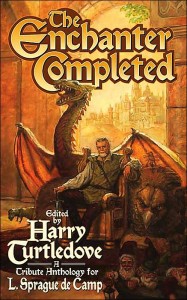 L. Sprague de Camp was a master in the science fiction and fantasy fields, known both for his adventure-packed, swashbuckling action stories and his humor-laced tales. His unique style inspired any number of today’s greatest writers, and now they’ve come together to honor de Camp with this anthology. In it, fifteen authors pay tribute to the master with stories of humorous adventure and good old-fashioned character-driven fun.
L. Sprague de Camp was a master in the science fiction and fantasy fields, known both for his adventure-packed, swashbuckling action stories and his humor-laced tales. His unique style inspired any number of today’s greatest writers, and now they’ve come together to honor de Camp with this anthology. In it, fifteen authors pay tribute to the master with stories of humorous adventure and good old-fashioned character-driven fun.
David Drake’s “A Land of Romance” follows the adventures of one minor mid-level marketing executive as he’s accidentally tapped for something far greater, and stranger. When his boss turns out to be something of a magician in need of a volunteer to travel to another dimension, who else but not-so-mild-mannered Howard Jones is ready to step up to the plate? Did we mention that there’s a girl to be won, as well? This story fits the de Camp atmosphere perfectly, serving as a great lead into the rest of the volume.
Michael T. Flynn gives us “The Ensorcelled ATM,” in which a disgruntled man attempts to take his revenge on a corporate headhunter, and ends up sucked into another world, where they have need of someone with his skills. Or rather, the skills of the man he was pretending to be. But there might be a solution which satisfies everyone, after all.
Richard Foss’ “Ripples” is an alternate history about some of history’s greatest philosophers, where one took a vastly different path in life, and the other had to try and stop him. It’s not what you’d expect. Chris Bunch turns in “Gun, Not For Dinosaur,” which is something of a sequel to a classic, well-known story. When one of the richest men in the world embarks upon a time-traveling safari back into the dawn of history, he has a truly insidious plan in mind, one which could tear the human race apart.
Esther M. Friesner’s “One For The Record” is a gently-told, tongue-in-cheek tale about a gentleman’s club and the strange events which befall it one day. It seems there’s something of a rash of people returning from the dead, in the Greek manner of things, and an old myth is about to get a new resolution. The way it all gets solved is acceptable, is somewhat gauche, and well-executed. Harry Turtledove, however, is bound to make a few people twitch with his tale of dentistry gone wrong in “The Haunted Bicuspid.” However barbaric we might find today’s practices to be, they’re nothing compared to what one man goes through in this story.
“Return to Xanadu,” by Lawrence Watt-Evans, focuses upon a simple harem girl whose encounter with the notorious Harold Shea upsets her normal life, even as it paves the way for her true destiny as one of literature’s greatest storytellers. Meanwhile, S.M. Stirling’s “The Apotheosis of Martin Padway” acts as a coda to the long and strange history of Martinus of Padua, a time-tossed man who once upon a time changed the world with his ideas from the future.
“The Deadly Mission of P. Snodgrass,” by Frederick Pohl, may be a reprint, but it’s still one of the greatest time-travel stories ever written, in its own exaggerated way. A man’s attempt to change the past may seem to alter things for the best, but ultimately, it turns out to be a drastic mistake. Laura Frankos’ “The Garden Gnome Freedom Front” is a hilarious look at those ubiquitous inhabitants of our lawns and gardens: the lawn gnome. Three young women have taken it upon themselves to liberate the poor creatures, but when magic intervenes and brings the gnomes to life, it signals a change in the way the game is played.
With other stories by Poul Anderson, Judith Tarr, Susan Schwartz, and Darrell Schweitzer to finish off the collection, this is quite an entertaining, satisfying anthology, combining the classic de Camp feel with modern sensibilities. Some of the stories served as wonderful follow-ups to his own mythos, while others merely invoked his style in a warmly familiar manner. I was very happy with the overall results.
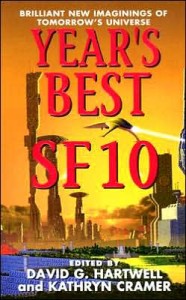 Is it that time of year again already? No, not prom season. Time for the various “Year’s Best” collections to trickle out. This time, it’s the Year’s Best SF #10, as collected by David Hartwell and Kathryn Cramer. As always, the usual caveats apply: selection is at the whim of the editor, your opinions may vary, all criteria are equally valid and subjective. That out of the way, I will note that Hartwell and Cramer have done very well so far in selecting a quality assortment of stories which successfully represent the potential of the field.
Is it that time of year again already? No, not prom season. Time for the various “Year’s Best” collections to trickle out. This time, it’s the Year’s Best SF #10, as collected by David Hartwell and Kathryn Cramer. As always, the usual caveats apply: selection is at the whim of the editor, your opinions may vary, all criteria are equally valid and subjective. That out of the way, I will note that Hartwell and Cramer have done very well so far in selecting a quality assortment of stories which successfully represent the potential of the field.
The lead story is Bradley Denton’s “Sergeant Chip,” which has seen a lot of acclaim since its publication. But then again, how often do you find a story told from the viewpoint of a military-trained, rather intelligent dog whose attention and dedication to both master and orders is so overwhelming? It’s a wonderful story, and the title character can make you believe in the term “Man’s best friend.”
Gregory Benford’s “First Commandment” is, on the surface, a tale about the cataloguing of every species on Earth, and the ultimate completion of said task. Below that, though, is the question of man’s duty to nature, as well as his duty to God. Are we fulfilling an ancient commandment, or have we managed to fail in our greatest task ever?
“Burning Day,” by Glenn Grant, is a cyberpunk murder mystery done in a classic noir-meets-Philip K. Dick style, where appearances are as deceiving as what’s underneath them. Full of twists and surprises, it’s an excellent, crisp story. “Scout’s Honor,” by Terry Bisson, is also a mystery, though something of a time-traveling one. Who’s been sending a scientist a running series of seemingly-fictional journal entries involving a modern man trapped back in the dawn of man’s history?
Gene Wolfe’s “Pulp Cover” is an homage to the lurid magazine covers of the ‘50s, and makes you really wonder, what did all the Bug-Eyed Monsters want with nubile Earth women? One businessman is about to find out, though not firsthand. Ken Liu’s story is even less comforting. In “The Algorithms for Love,” a brilliant toy designer creates a doll that acts so lifelike, it’s hard to distinguish it from the real thing. Unfortunately, her sanity erodes along the way, to the point where reality seems just as predictable as any computerized toy.
Ray Vukcevich’s “Glinky” continues to be a mind-spraining story of collapsing universes, private detectives, mysterious women, and busses, as multi-layered and confusing as the last time I read it. But when realities collide, that’s to be expected. Janeen Webb’s “Red City” is another time-traveling tale, but with a different twist. As the editors say, “there’s a prophet, a harem, a chess game, and a time loop.”
Jack McDevitt looks at what happens when we attempt not just to play God, but to try and improve upon His creations, in a story aptly entitled “Act of God.” Robert Reed’s “Wealth” is the story of an AI whose ability to maintain and handle vast amounts of monetary wealth has given him amazing foresight into the future, a future he has long-ranging plans for. Matthew Hughes’ entertaining “Mastermindless” is the first of his stories featuring freelance discriminator, Henghis Hapthorn. Think Sherlock Holmes in the far future, with a dose of comedy and an AI assistant. Now, for the purposes of this story, strip him of his vast intelligence so he’s forced to solve the case based on what his AI thinks he’d usually do. The solution is right there, all along. I greatly enjoyed this story the first time it appeared, and I’ve been following the subsequent adventures of Henghis Hapthorn ever since.
James Stoddard’s “The Battle of York” is a postmodern, far future myth about American history, chock-full of interesting misconceptions, blended history, and anachronisms. In other words, it’s the past as the future might remember it, and rather fun to read. “The Dark Side of Town,” by James Patrick Kelly, is a futuristic story about domestic strife in a dystopian society where expensive drugs offer a rich fantasy life.
Sean McMullen gives us “The Cascade,” in which a young man becomes accidentally embroiled in a conspiracy to jumpstart a weakened space program at any costs. The decisions he’s forced to make will haunt him for the rest of his life, whether they’re right or wrong. Neal Asher’s “Strood” is all about the perils of communicating with aliens. One man, searching for a cure for his incurable cancer, has accepted an invitation to a distant world, only to discover what seems to be an unthinkable plot against the human race.
“The Eckener Alternative” by James Cambias is a time-travel story with a unique focus: the protagonist keeps trying to change history for the sole purpose of bringing back zeppelins as a viable industry, and his efforts keep going awry. Brenda Cooper’s “Savant Songs” is a quantum romance involving a brilliant autistic woman and her normal assistant, and the secrets they quest for across multiple universes.
Overall, the stories collected in this volume are consistently excellent, with nary a misfire to be found. You’d be hard-pressed to find a better representation of what the science fiction field had to offer for 2004, and I highly recommend this to fans of short science fiction, since I doubt anyone’s read every story in here. Even I found a fair number I wasn’t familiar with.
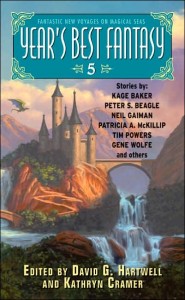 Coming right on the heels of the SF volume is this lovely collection of, as the title suggests, Hartwell and Cramer’s picks for best fantasy stories of the previous year. Everything I said about the SF collection applies here: it’s an excellent selection of stories from a wide range of sources, and it serves as an excellent buffet-style sampling of what the field had to offer in 2004.
Coming right on the heels of the SF volume is this lovely collection of, as the title suggests, Hartwell and Cramer’s picks for best fantasy stories of the previous year. Everything I said about the SF collection applies here: it’s an excellent selection of stories from a wide range of sources, and it serves as an excellent buffet-style sampling of what the field had to offer in 2004.
Robert Reed’s “The Dragons of Summer Gulch” is a clever blend of archaeology, mythology, evolution, and high-stakes frontier exploration, as an entire industry built around the finding of fossilized dragon bones comes to a head when one lucky prospector makes a monumental discovery, one people are willing to kill over.
Theodora Goss’ “Miss Emily Gray” is a Mary Poppinsesque story with a twist and some subtle attitude, while John Kessel’s “The Baum Plan for Financial Independence” is a story about two small-time crooks who discover their own metaphorical rainbow, one which really does change their lives forever. Dale Bailey explores the ways the world might end in “The End of the World as We Know it.” Wry and self-referential, it examines the many ways civilization might take a nosedive, with a most unassuming protagonist.
Kage Baker’s “Leaving His Cares Behind Him” is a typical story about a most atypical young man about town. On the surface, he’s a wastrel, spending money he doesn’t have and getting into all sorts of trouble. However, this younger son of a nobleman has a bizarre secret, and a very dangerous family. A truly enjoyable story with a surprisingly likeable main character, I hope we’ll see more of this world in the future.
“The Problem With Susan,” by Neil Gaiman is a subtle piece that picks up on a lingering concern regarding the Narnia books, when a young reporter goes to interview an elderly professor and makes a strange discovery. Kim Westwood’s “Stella’s Transformation” is a beautifully-told story that looks at an unhappy woman who starts to experience some unusual, positive changes in her life. It’s part-dream, part-romance, and wholly intriguing.
In “Quarry,“ Peter S. Beagle returns to the world and the characters last seen in The Innkeeper’s Song, when he explores how two characters – one an aging shape shifter/trickster, the other a youthful runaway – met and began to bond. John Meaney’s “Diva’s Bones” looks at a unique sort of afterlife/underworld, where the dead provide fuel to power the cities of the living. However, some bones have a power all unto themselves, and some people will do anything for that power. It’s not quite a detective story, not quite a mystery.
“Life in Stone,” by Tim Pratt, follows an aging assassin as he undertakes the greatest task in a long career: killing an unkillable man. Richard Parks weaves a new sort of ghost story/mystery in “A Hint of Jasmine,” in which one man uses technology to bridge the gap between the living and the dead in order to help both sides find resolution.
Joel Lane’s “Beyond the River” is a cautionary tale about what happens to our fantasy worlds when corporate interests change them for the worse. Terry Bisson’s “Death’s Door” is a weird, disturbing tale that looks at a world where, for a time, people are unable to die, no matter how much they might need to.
These, and a number of other fine stories by authors such as Tanith Lee, Gene Wolfe, and Nalo Hopkinson, make this collection worth checking out if you want to see what you might have missed last year.
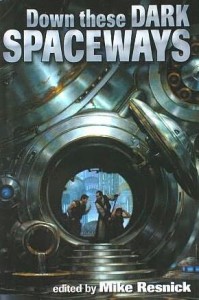 Another collection of original short fiction commissioned by the Science Fiction Book Club, Down These Dark Spaceways brings together half a dozen authors to spin tales of science fiction mystery, murder, and intrigue. They combine the fine art of the classic mystery with the fantastic trappings of science fiction, and the resulting blend is quite well-done.
Another collection of original short fiction commissioned by the Science Fiction Book Club, Down These Dark Spaceways brings together half a dozen authors to spin tales of science fiction mystery, murder, and intrigue. They combine the fine art of the classic mystery with the fantastic trappings of science fiction, and the resulting blend is quite well-done.
In Mike Resnick’s “Guardian Angel,” a private detective is hired to track down and retrieve a teenage runaway who has, in the time-honored tradition of things, gone to join the circus. It’s a world-hopping adventure as our hero follows the traveling carnival in search of his target, dodging all manner of hostile people along the way. But the more he pursues this case, the more questions arise: why did the kid run away? What secrets are his estranged parents (one an interstellar criminal kingpin) hiding? And who’s trying to kill the runaway? The answers are there for the taking, if our hero can live long enough.
David Gerrold gives us an intriguing story of time travel and crime prevention in “In The Quake Zone.” An operative who travels the time-torn streets of Los Angeles over a variety of decades, acting to prevent various crimes before they can happen again for the first time, the protagonist finds himself inexplicably affected on an emotional level by his latest case: protecting the future victims of a serial killer. However, there’s something even stranger going on, and the answers lie in the future, or do they? This story is fascinating on a great many levels, not the least of which is its unusual setting, a Los Angeles where time has become fluid and changeable over the course of a century.
Robert Reed’s “Camouflage” takes place aboard the world-sized, galaxy-traveling ship of his Marrow setting. Here, a former Captain, long since resigned, disgraced, and gone into hiding, is pulled out of his centuries-long retirement to help solve a strange murder. In a ship where many different species and faiths coexist, and where immortality is commonplace, it takes a very special sort of desire to see someone dead and make it happen. The man known as Panir has spent a very long time staying hidden; should he refuse this job, the life he’s built for himself for be destroyed. As a result, he’s compelled to dig deep into the sordid secrets of a woman and her various interspecies marriages, until he discovers who’s been killing her past husbands, and why. Full of twists and turns and wild technology, this story takes full advantage of its setting to tell an unpredictable, fascinating tale.
In “The Big Downtown,” by Jack McDevitt, a female P.I. is hired to navigate her way through a tangled series of lies, cover-ups, and murder, to get to the bottom of a boating accident in which an up-and-coming artist died. Strongly reminiscent of Ross MacDonald’s Lew Archer stories (in my opinion), this one’s a classic tale of greed and betrayal, right down to the thugs who come to beat up our hero and scare her off the trail. However, the inclusion of high-tech elements such as AIs and holograms makes for even more fun.
Robert Sawyer’s “Identity Theft” is set on Mars, where it’s become common to have an entirely new, artificial body created, and one’s mind transferred into it. Just as common are the people who take advantage of the technology to go and hunt for ancient artifacts out on Mars’ surface, as part of a lucrative (if hazardous and unpredictable) industry. And of course, there are those driven to murder by what they find. When our hero is hired to find a missing husband, he quickly finds a dead body, and a bizarre mystery involving stolen identities, hidden artifacts, and plenty of lies to go around. It’s an interesting take on the nature of the human consciousness, and what makes a person truly alive and unique.
Add to this Catherine Asaro’s “The City of Cries,” about a runaway prince, and you have a thoroughly solid collection of science fiction mysteries for your pleasure. I was very happy with this collection, and recommend it to anyone who enjoys this sort of crossover fiction.
